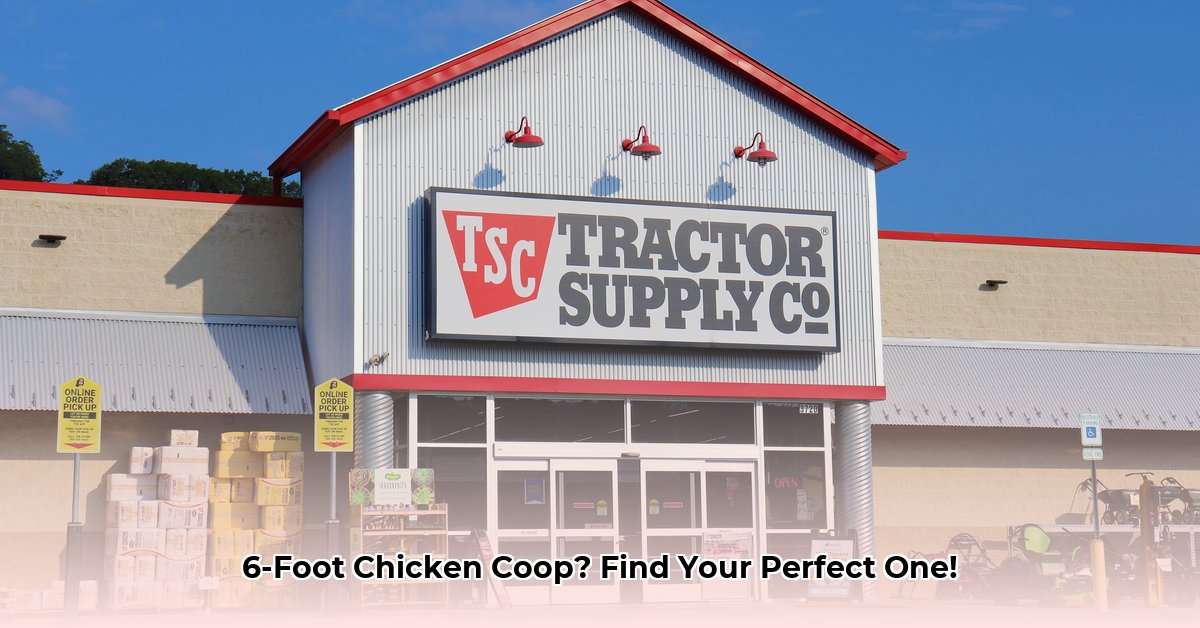
Raising backyard chickens is a rewarding experience, providing fresh eggs and a connection to nature. But securing the right coop is paramount. This guide focuses on choosing and maintaining a suitable 6-foot chicken coop from Tractor Supply for your six hens. We'll cover coop selection, safe setup, essential maintenance, and strategies to protect your flock from predators. For additional resources on chicken runs, check out this helpful guide.
Factors to Consider When Choosing Your Coop
Before buying, several crucial factors will influence your coop choice. Let's explore the key considerations:
Coop Size and Breed Compatibility
Six chickens need adequate space. However, the ideal coop size depends on the breed. Larger breeds like Orpingtons require more space than smaller breeds like Bantam varieties. Consider future expansion--a slightly larger coop may be a worthwhile investment. A general rule of thumb is 4 square feet per bird in the sleeping area. Do you really have enough space with a 6-foot coop?
Material Showdown: Wood vs. Metal
This is a significant decision. Wooden coops offer a charming, rustic aesthetic. But they demand regular maintenance (painting, staining) to prevent rot and insect infestations. Metal coops, while often pricier initially, are typically more durable and easier to clean (simply hose them down!). However, they can become excessively hot in summer and frigid in winter, impacting your hens' comfort. Consider your climate and maintenance commitment.
Predator Protection: A Must-Have Feature
Protecting your flock from predators like raccoons, foxes, and even determined dogs is crucial. Look for a coop with robust construction, secure latches, and strong wire mesh (hardware cloth, with 1/4-inch or smaller mesh, is superior to chicken wire). Enhance security further by burying the mesh several inches underground to prevent digging. Don't compromise on safety! Are you confident in the coop's ability to withstand a determined predator?
Ventilation: Ensuring Fresh Air and Health
Proper ventilation prevents ammonia buildup (a respiratory irritant), regulates temperature, and protects your chickens from heat stress in summer and freezing temperatures in winter. Seek coops with sufficient, ideally adjustable, vents to manage airflow according to the season. A well-ventilated coop contributes directly to your hens' overall health and happiness. How does the ventilation system of your chosen coop perform?
Cleaning Ease and Maintenance
Regular cleaning is essential for a healthy flock. Choose a coop with features that simplify this task, such as easy-to-open doors, removable roosts, and easy-to-clean floors. Easy access to all areas minimizes cleaning time and effort. This will positively impact your long-term commitment to caring for your flock. How easily can you clean the chosen coop?
Regulatory Compliance: Local Ordinances
Before purchasing, check local ordinances. Some areas regulate the number of chickens allowed, coop size, and setbacks from property lines. Compliance with local regulations ensures you avoid potential fines or conflicts. Have you checked your local regulations regarding backyard poultry?
Selecting and Setting Up Your Tractor Supply Coop: A Step-by-Step Guide
Now, let's move on to choosing and setting up your new coop.
Thorough Research: Explore Tractor Supply's website, paying close attention to detailed product descriptions and customer reviews. Look for recurring themes.
In-Person Inspection (if possible): Visit your local store to examine coops firsthand, assess construction quality, and check all latches and doors.
Strategic Coop Placement: Choose a location that balances sunlight for warmth and vitamin D with adequate shade during peak heat. Ensure excellent drainage to prevent disease and pest problems. Position the coop away from potential predator access points.
Careful Assembly: Meticulously follow the manufacturer's instructions; a rushed assembly can compromise structural integrity. Double-check all fastenings.
Maintaining Your Coop: A Guide to Long-Term Care
Regular maintenance keeps your coop in optimal condition and your flock healthy.
Cleaning Schedule: Remove droppings daily and perform deep cleaning (with poultry-safe disinfectant) at least monthly, more frequently in warmer months.
Pest Control: Regularly monitor for pests (mites, lice, rodents) and address any infestations promptly.
Repair Protocol: Immediately repair any coop damage. Small neglected issues can quickly escalate into larger problems.
Coop Comparison: Wood vs. Metal at a Glance
| Feature | Wooden Coop | Metal Coop |
|---|---|---|
| Initial Cost | Generally lower | Often higher |
| Durability | Moderate; susceptible to rot and pests | High; generally more weather-resistant |
| Maintenance | Higher; regular painting/staining needed | Lower; easier cleaning |
| Temperature | More susceptible to temperature fluctuations | Can overheat in summer, freeze in winter |
| Aesthetics | Rustic and charming | Modern and functional |
Choosing the right Tractor Supply 6-foot chicken coop is a critical step towards successful backyard chicken keeping. By carefully considering these factors and following these guidelines, you'll create a safe, comfortable, and long-lasting home for your feathered friends.